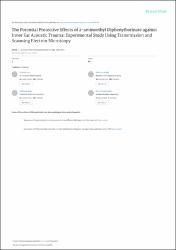| dc.contributor.author | Kaymakci, Mustafa | |
| dc.contributor.author | Acar, Mustafa | |
| dc.contributor.author | Burukoğlu, Dilek | |
| dc.contributor.author | Kutlu, Hatice Mehtap | |
| dc.contributor.author | Shojaolsadati, Paria | |
| dc.contributor.author | Cingi, Cemal | |
| dc.contributor.author | Muluk, Nuray Bayar | |
| dc.date.accessioned | 2019-10-20T08:00:27Z | |
| dc.date.available | 2019-10-20T08:00:27Z | |
| dc.date.issued | 2015 | |
| dc.identifier.issn | 1308-7649 | |
| dc.identifier.uri | https://dx.doi.org/10.5152/iao.2015.752 | |
| dc.identifier.uri | https://hdl.handle.net/11421/16080 | |
| dc.description | WOS: 000357533000002 | en_US |
| dc.description | PubMed ID: 26223709 | en_US |
| dc.description.abstract | OBJECTIVE: In this prospective experimental study, we investigated the preventive effects of 2-aminoethyl diphenylborinate (2-APB) in rats exposed to acoustic trauma (AT). Light microscopic, transmission electron microscopic (TEM), and scanning electron microscopic (SEM) examinations were performed. MATERIALS and METHODS: Eighteen healthy Wistar albino rats were divided into the following three groups: groups 1 (control), 2 (AT), and 3 (AT+APB). The rats in groups 2 and 3 were exposed to AT; in group 3 rats, 2-APB at 2 mg/kg was also administered, initially transperitoneally, after 10 min. RESULTS: During the light microscopic, TEM, and SEM examinations, the structures of the cochlear hair cells, stereocilia, and Deiter's cells were normal in the control group. In the AT group, the organ of Corti and proximate structures were damaged according to the light microscopic examination. During the TEM examination, intense cellular damage and stereocilia loss were detected, while during the SEM examination, extensive damage and stereocilia loss were observed. Decreased damage with preserved cochlear structure was detected during the light microscopic examination in the AT+APB group than in the AT group. During the TEM and SEM examinations, although stereocilia loss occurred in the AT+APB group, near-normal cell, cilia, and tectorial membrane structures were also observed in the AT+APB group compared with the AT group. CONCLUSION: 2-APB may have protective effects against AT damage of the cochlea. The main mechanism underlying this effect is the inhibition of the vasoconstriction of the cochlear spiral modiolar artery, thereby improving cochlear blood flow. We conclude that 2-APB may also be effective if used immediately following AT. | en_US |
| dc.description.sponsorship | Continuous Education and Scientific Research Association | en_US |
| dc.description.sponsorship | With the exception of data collection, the preparation of this paper, including design and planning, was supported by the Continuous Education and Scientific Research Association. Only scientific support was provided; no grant or funding was received. | en_US |
| dc.language.iso | eng | en_US |
| dc.publisher | Aves | en_US |
| dc.relation.isversionof | 10.5152/iao.2015.752 | en_US |
| dc.rights | info:eu-repo/semantics/openAccess | en_US |
| dc.subject | 2-Aminoethyl Diphenylborinate (2-Apb) | en_US |
| dc.subject | Acoustic Trauma (At) | en_US |
| dc.subject | Electron Microscopy | en_US |
| dc.title | The Potential Protective Effects of 2-aminoethyl Diphenylborinate against Inner Ear Acoustic Trauma: Experimental Study Using Transmission and Scanning Electron Microscopy | en_US |
| dc.type | article | en_US |
| dc.relation.journal | Journal of International Advanced Otology | en_US |
| dc.contributor.department | Anadolu Üniversitesi, Fen Fakültesi, Biyoloji Bölümü | en_US |
| dc.identifier.volume | 11 | en_US |
| dc.identifier.issue | 1 | en_US |
| dc.identifier.startpage | 1 | en_US |
| dc.identifier.endpage | 5 | en_US |
| dc.relation.publicationcategory | Makale - Uluslararası Hakemli Dergi - Kurum Öğretim Elemanı | en_US |
| dc.contributor.institutionauthor | Kutlu, Hatice Mehtap | |


















